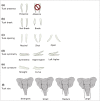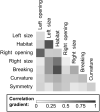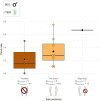Effect of the habitat and tusks on trunk grasping techniques in African savannah elephants
- PMID: 38646004
- PMCID: PMC11027014
- DOI: 10.1002/ece3.11317
Effect of the habitat and tusks on trunk grasping techniques in African savannah elephants
Abstract
Among tetrapods, grasping is an essential function involved in many vital behaviours. The selective pressures that led to this function were widely investigated in species with prehensile hands and feet. Previous studies namely highlighted a strong effect of item properties but also of the species habitat on manual grasping behaviour. African savannah elephants (Loxodonta africana) are known to display various prehensile abilities and use their trunk in a large diversity of habitats. Composed of muscles and without a rigid structure, the trunk is a muscular hydrostat with great freedom of movement. This multitasking organ is particularly recruited for grasping food items while foraging. Yet, the diet of African savannah elephants varies widely between groups living in different habitats. Moreover, they have tusks alongside the trunk which can assist in grasping behaviours, and their tusk morphologies are known to vary considerably between groups. Therefore, in this study, we investigate the food grasping techniques used by the trunk of two elephant groups that live in different habitats: an arid study site in Etosha National Park in Namibia, and an area with consistent water presence in Kruger National Park in South Africa. We characterised the tusks profiles and compared the grasping techniques and their frequencies of use for different foods. Our results show differences in food-grasping techniques between the two groups. These differences are related to the food item property and tusk profile discrepancies highlighted between the two groups. We suggest that habitat heterogeneity, particularly aridity gaps, may induce these differences. This may reveal an optimisation of grasping types depending on habitat, food size and accessibility, as well as tusk profiles.
Keywords: Loxodonta africana; Proboscidea; food manipulation; muscular hydrostat; prehension; skill.
© 2024 The Authors. Ecology and Evolution published by John Wiley & Sons Ltd.
Conflict of interest statement
The authors declare that there are no conflicts of interest.
Figures













Similar articles
-
The relationship between distal trunk morphology and object grasping in the African savannah elephant (Loxodonta africana).PeerJ. 2022 Mar 28;10:e13108. doi: 10.7717/peerj.13108. eCollection 2022. PeerJ. 2022. PMID: 35368332 Free PMC article.
-
Estimating exposed pulp lengths of tusks in the African elephant (Loxodonta africana africana).J S Afr Vet Assoc. 2008 Mar;79(1):25-30. doi: 10.4102/jsava.v79i1.236. J S Afr Vet Assoc. 2008. PMID: 18678188
-
Maximum trunk tip force assessment related to trunk position and prehensile 'fingers' implication in African savannah elephants.PLoS One. 2024 May 14;19(5):e0301529. doi: 10.1371/journal.pone.0301529. eCollection 2024. PLoS One. 2024. PMID: 38743734 Free PMC article.
-
DETECTION OF ELEPHANT ENDOTHELIOTROPIC HERPESVIRUS (EEHV) IN FREE-RANGING AFRICAN ELEPHANTS (LOXODONTA AFRICANA) IN THE KRUGER NATIONAL PARK, SOUTH AFRICA.J Wildl Dis. 2023 Jan 1;59(1):128-137. doi: 10.7589/JWD-D-22-00015. J Wildl Dis. 2023. PMID: 36584337
-
Memory-Based Navigation in Elephants: Implications for Survival Strategies and Conservation.Vet Sci. 2025 Mar 30;12(4):312. doi: 10.3390/vetsci12040312. Vet Sci. 2025. PMID: 40284814 Free PMC article. Review.
References
-
- Abdi, H. , & Valentin, D. (2007). Multiple correspondence analysis. In Salkind N. J. (Ed.), Encyclopedia of measurement and statistics (pp. 1–13). SAGE Publications.
-
- Anderson, M. J. (2001). A new method for non‐parametric multivariate analysis of variance. Austral Ecology, 26, 32–46. 10.1111/j.1442-9993.2001.01070.pp.x - DOI
-
- Anderson, M. J. (2017). Permutational multivariate analysis of variance (PERMANOVA). In Balakrishnan N., Colton T., Everitt B., Piegorsch W., Ruggeri F., & Teugels J. L. (Eds.), Wiley StatsRef: Statistics reference online (pp. 1–15). John Wiley & Sons, Ltd. 10.1002/9781118445112.stat07841 - DOI
-
- Auer, C. (1997). Chemical quality of water at waterholes in the Etosha National Park. Madoqua, 1997, 121–128. 10.10520/AJA10115498_463 - DOI
LinkOut - more resources
Full Text Sources

